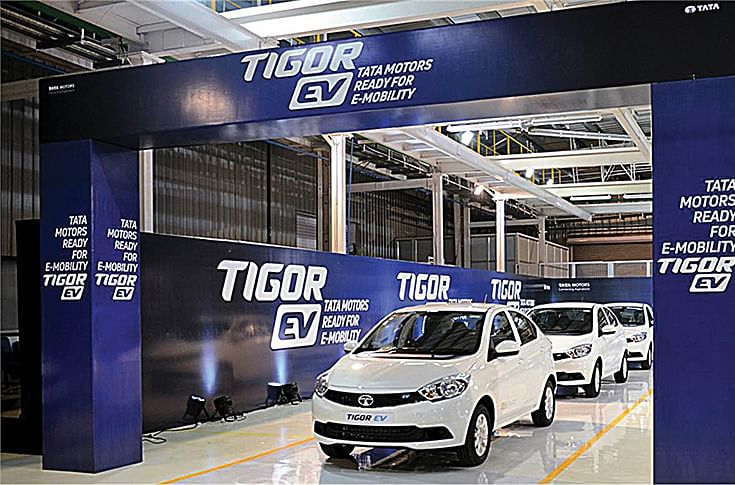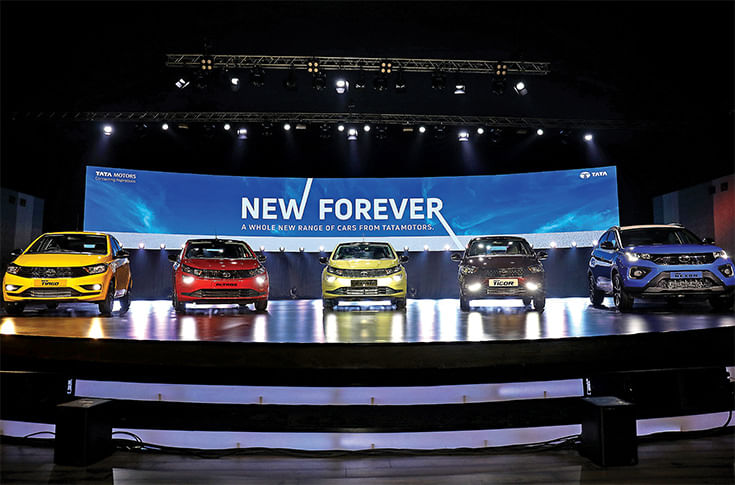Shailesh Chandra: ‘Our entire passenger vehicle portfolio can go electric.’
A few days before the Nexon EV celebrated its first launch anniversary, Shailesh Chandra, President – PVBU, Tata Motors spoke about scaling up the business, growth prospects for Tata EVs in India and overseas.
Tata Motors’ tryst with electric vehicles began in 2006 with an electric Indica. Fifteen years later, it is leading the passenger vehicle segment of the small but growing EV industry. A few days before the Nexon EV celebrated its first launch anniversary, Shailesh Chandra, President – PVBU, Tata Motors spoke about scaling up the business, growth prospects for Tata EVs in India and overseas, what the EV customer today needs, and more.
Going by the performance of the Nexon EV, it looks like your bet on the EV market with it is paying off. Where does Tata Motors’ EV journey stand currently and how do you plan to scale it up from here?
You said that I'm a big proponent of electric vehicles. For me it's not about being a proponent but being practical to what I'm seeing as the evolving trend. One can see that directionally there is a transition which is imminent towards electrification but it's going to be a journey which will have a varying mix of conventional vehicles as well as EVs, and a few other alternate technologies might also be in there. Clearly, there are forces which are driving things in favour of electric. The first and biggest driver as far as India is concerned is that it has 14 out of the 15 most-polluted cities of the world in India, which has an issue of 75 to 80 percent of dependence on oil through imports. And then there’s the whole energy security issue. All these point to a greater urgency as far as electrification in India is concerned.
On the other side, emission norms are making conventional vehicles more expensive and as the scale of EVs is growing, battery prices are falling. So, it's a no brainer as to what's going to happen in the future.
Electrification might see an inflection point in the coming years and once the barriers are addressed and resolved, the myths around EVs, which is some of the work that we have been doing in the past couple of years, will be addressed. It has been proven that if you are able to break the myths and are able to give a compelling proposition to a customer, adoption can happen because the performance and rest of the things are very superior.

How many Tata EVs have been sold so far, and how many of them are Nexon EVs?
In total we would be in the range of 4,500 or so. We are very close to touching the 3,000-mark as far as the Nexon EV is concerned. The Tigor EV would have sold more than 1,500 units.
What are the key EV customer insights gained so far? Are some of the customer needs different than in the conventional vehicle space?
Like buying any car, there are three four things that a customer looks for. The customer is looking for something which is compelling and convincing and this revolves around performance, features, economics which is the cost of ownership, and the price. As far as EVs are concerned, there will be a certain extent of price premium customers will be ready to pay, a certain expectation of a baseline performance you get in a conventional vehicle, and no compromise when shifting from one technology to another. And, of course, the economics should make sense.
The second additional aspect the customer is looking for specifically because this is a new technology is the comfort and convenience part, which is the barrier today and revolves around the charging infrastructure. They have not seen one cycle of ownership, how a particular car and the new technology behave over the ownership period; whether it is durable and reliable, and whether a battery replacement would cost heavily. These are the uncertainties around the new technology for which the customer is seeking answers.
Therefore, as a company, we have to scale up this whole thing because if you're able to address all these, then there is no reason a customer is not going to consider EVs as a mainstream choice. So we have to bring more choices, because every customer has a unique choice. That is why you have so many sub-segments. As far as price premium over a conventional vehicle is concerned, 15-20 percent is a reasonable range what the customer is expecting. If you are able to meet that criterion, I think you are in for consideration.
The Nexon is currently leading the electric PV pack in India. Would the goal for Tata Motors be to lead the electric passenger vehicle space even after the industry reaches critical scale?
In the first nine months of FY2021, around 2,000 or so out of 3,500 EVs sold in India are Tata EVs which translates to a share of around 65 percent. So, definitely it has created waves in this segment. Going forward, this is going to see only greater adoption because every quarter we have been seeing growth coming in the segment, on the back of the experience of Nexon EV owners’, their videos and their converstions. That gives more confidence to those who are fence-sitters.

Tigor EV led Tata Motors'entry into the EV space, with the first rollout from the Sanand plant on December 6, 2017.
Going by the global electrification trend, it would be fair to assume that almost every OEM including Tata Motors will have a provision for electrification in every segment. Is the newest addition in your portfolio, the Safari, also a candidate for electrification?
Tata Motors’ future architectures are Alpha and Omega in the passenger vehicle segment, and we have gone with the piggyback approach on the investments for EVs. These were conceived to be electrification-ready. Both the platforms are capable of providing electrification with the range that one needs to deliver as the market evolves. The new Safari, which uses the very capable Omega architecture and hails from the Land Rover D8 platform, has that capability. It's a matter of timing when you choose to get into electrification in different segments because this needs certain criteria to be met. Otherwise, it might not be a credible solution.
For instance, if there’s a plan to introduce an electric vehicle in the price-sensitive hatchback segment, it will be very difficult to deliver a real-world driving range of over 200 kilometres at a price which is not exorbitantly higher than a conventional hatch. Therefore, today the Nexon EV is able to deliver that, which is why it is in the sweet spot as far as that segment is concerned. Similarly, the Safari and HBX would be launched later on. All these will be candidates for electric as far as our entire portfolio is concerned.
As you build the electric vehicle business in India, are you also exploring potential to take Tata EVs to global markets, since the entry barrier compared to ICE vehicles is much lower and there’s no issue of different emission norms in different markets?
Our focus will be on the Indian market and the Indian subcontinent for the next one or two years. You are absolutely right about the different emission barriers, especially in the important auto markets, which acted as an entry barrier as Indian OEMs were one or two emission norms behind. electric vehicles take away that barrier completely and therefore unleash the opportunity to get our vehicles, but you still have to create very market-specific solutions. We have shortlisted some of the markets where we see there can be an opportunity in the future at the right time.
What is the size of investments that you have earmarked for the electric vehicle side of the business, on an annual basis?
We don't disclose investment numbers but I can only say that it's a smaller fraction of what we would do while developing a whole specific passenger car because the EV strategy, as far as we are concerned, is piggy-backing on investments that have already been made on the passenger vehicle side. But as the market evolves and the scale increases, the technology prices of electric vehicles come down and one would definitely like to go for more efficient products on dedicated platforms.

Like electrification, collaboration is also a growing global trend much of it driven by the electrification trend. It was one of the objectives when Tata Motors decided to carve out the passenger vehicle business unit, after clubbing the EV business with it, into a separate subsidiary. Where does that plan stand currently and what are the top reasons why you would choose to collaborate with company A or company B now?
Collaboration is really a global imperative. This is what we announced also when we decided to make the business into a subsidiary. The imperative comes from the fact that during the next decade we have to invest into multiple things — emission norms which are becoming very stringent,and the four disruptors called ACES (Autonomous driving, Connected vehicles, Electrification, and Shared mobility). So, the next decade in terms of investments is not the same as what it was in the last 10 years. The profile of investment has changed and therefore collaboration becomes an imperative for all the auto players. I would say that that's a long-term imperative for us, not an immediate necessity. To win sustainably in a manner that we are growing faster than the industry is more of a necessity and that is the focus right now.
As far as the EV world is concerned, it is not about just making product and the related technologies. You will not be able to drive adoption by just doing that. You have to develop the entire ecosystem in parallel, otherwise you will not see the adoption of electric vehicles. Therefore, as far as EVs are concerned, we are primarily looking for partnership in the ecosystem space and this is where we found the different Tata companies — Tata Motors, Tata AutoComp, Tata Chemicals, Tata Power, Tata Motors Finance, Croma — coming together under the umbrella of what we called the Tata uniEVerse where we utilised this unique differentiator for us as a Group, of getting the domain expertise of our different companies to develop this ecosystem.
This interview was first published in Autocar Professional's February 1, 2021 issue.
RELATED ARTICLES
India: A Bastion Of Stability for Schaeffler
German autoparts maker Schaeffler’s CEO, Klaus Rosenfeld, describes India’s role in the company’s €24-25 billion empire....
'No Question of Us Being Late' - Suzuki India on e-2Wheeler Market
Suzuki Motorcycle India believes its EV entry is timely as the market is now mature enough to grow off genuine demand ra...
'India Can Become a Major Pillar for Us' - Marquardt Group
Björn Twiehaus, CEO of Marquardt Group, and Vishal Narvekar, the company's India GM, share their outlook on the Indian m...





 04 Mar 2021
04 Mar 2021
 57650 Views
57650 Views





 Ketan Thakkar
Ketan Thakkar


 Angitha Suresh
Angitha Suresh

 Darshan Nakhwa
Darshan Nakhwa

